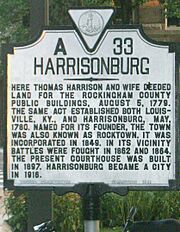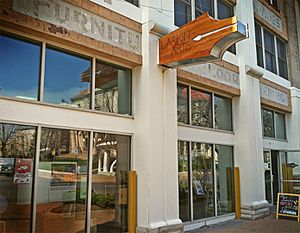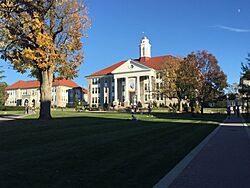Harrisonburg, Virginia facts for kids
Quick facts for kids
Harrisonburg, Virginia
|
||
|---|---|---|
| City of Harrisonburg | ||
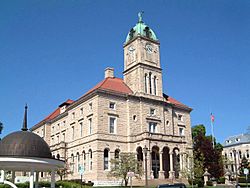
Rockingham County Courthouse in Court Square in downtown Harrisonburg
|
||
|
||
| Nickname(s):
The Friendly City, Rocktown, H'burg, The Burg, Friendly by Nature
|
||
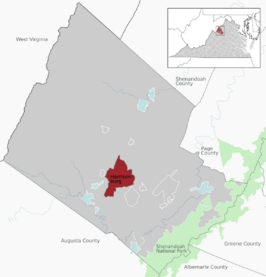
Harrisonburg enclaved within the Rockingham County
|
||
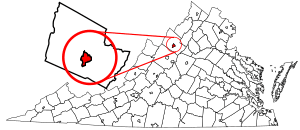
Location of Harrisonburg in the Commonwealth of Virginia
|
||
| Country | ||
| State | ||
| County | None (Independent city) | |
| Founded | 1779 | |
| Incorporated | 1916 | |
| Founded by | Thomas Harrison | |
| Named for | Thomas Harrison | |
| Government | ||
| • Type | Council-manager government | |
| Area | ||
| • Total | 17.39 sq mi (45.04 km2) | |
| • Land | 17.34 sq mi (44.91 km2) | |
| • Water | 0.05 sq mi (0.13 km2) | |
| Elevation | 1,325 ft (404 m) | |
| Population
(2020)
|
||
| • Total | 51,814 | |
| • Density | 2,979.5/sq mi (1,150.40/km2) | |
| Time zone | UTC-5 (EST) | |
| • Summer (DST) | UTC-4 (EDT) | |
| ZIP Codes |
22801–22803, 22807
|
|
| Area code(s) | 540 | |
| FIPS code | 51-35624 | |
| GNIS feature ID | 1498489 | |
| Website | www.harrisonburgva.gov | |
Harrisonburg is a special kind of city in Virginia, USA. It's called an independent city because it's not part of any county. It's also the main town for Rockingham County, even though they are separate.
Harrisonburg is known as "The Friendly City." In 2020, about 51,814 people lived here. It's a busy place with two big universities: James Madison University (JMU) and Eastern Mennonite University (EMU).
The city is very diverse, meaning people from many different backgrounds live here. Since 2002, over 1,900 refugees have made Harrisonburg their home. Students in Harrisonburg City Public Schools speak 55 different languages! The most common languages are Spanish, Arabic, and Kurdish. More than one-third of students are learning English as a second language.
Contents
History of Harrisonburg
The first English explorers likely passed through this area in 1716. Harrisonburg was first called "Rocktown." It was named after Thomas Harrison. He was a son of early English settlers. In 1737, Harrison settled in the Shenandoah Valley. He eventually owned a lot of land, about 12,000 acres. This land was where two important roads met.
In 1779, Thomas Harrison gave 2.5 acres of his land for a courthouse. The next year, he gave another 50 acres. This area is now known as "Historic Downtown Harrisonburg." In 1849, Harrisonburg started to have a local government with a mayor. But it didn't officially become an independent city until 1916. Today, the city is run by a council–manager government.
During the American Civil War, a small battle happened near Harrisonburg in 1862. A Confederate Army colonel named Turner Ashby was killed there. Over the years, the city has continued to grow.
Newtown: A Community's Story
After the Civil War, in 1865, enslaved people in the Shenandoah Valley became free. Many of them created a town called Newtown near Harrisonburg. Later, Newtown became part of Harrisonburg, probably around 1892.
Today, the old Newtown area is in the northeast part of downtown Harrisonburg. It's still home to most of Harrisonburg's Black churches. These include First Baptist and Bethel AME. The modern Boys and Girls Club is in the old Lucy Simms schoolhouse. This school was once used for Black students during the time of segregation.
Urban Renewal and Its Impact
In the 1960s, a big part of this Black neighborhood was changed. The city government used money from the federal government. They called this "urban renewal" or "Project R-4." The city decided Newtown was a "slum." This meant they could force Black families to sell their homes. Then, they tore down the neighborhood.
Many residents were offered very low prices for their homes. They couldn't afford new ones. Many families had to move into public housing. Some even left Harrisonburg completely. It's thought that between 93 and 200 families lost their homes.
Many Black-owned businesses also closed because they couldn't afford to reopen. Important places like the Colonnade, a community center, were lost. The Old First Baptist Church was also torn down, but it was later rebuilt. Newtown Cemetery, a historic African American cemetery, was also affected. Part of it was paved over, and some headstones are now very close to the street.
City Roads and Growth

Major roads in Harrisonburg include Interstate 81. This is the main highway that goes north and south through western Virginia. Other important roads are U.S. Route 11 and U.S. Route 33.
In 2002, people in Harrisonburg talked about making downtown a walking-only area. They decided to keep Main Street open to cars. But these talks led to a strong desire to improve downtown.
In 2003, a group called Harrisonburg Downtown Renaissance was formed. Their goal was to make downtown lively again. In 2004, downtown Harrisonburg was recognized as a historic district. This means its old buildings are protected.
The city spent over $1 million in 2008 to improve sidewalks and street lighting downtown. They also added special signs to help visitors find their way around. In 2014, Downtown Harrisonburg was named a "Great American Main Street." It was also called Virginia's first "culinary district" because of its many great restaurants.
Harrisonburg also has a small train yard. Trains carry grain and ethanol through the city. Public transportation is available through Harrisonburg Transit. There are also intercity bus services.
Culture and Fun
Harrisonburg has won several awards. It was called a "#6 Favorite Town in America" by Travel + Leisure in 2016. It was also named the "#3 Happiest Mountain Town" by Blue Ridge Country Magazine.
The city is known as "Virginia's first Culinary District." This means it's a great place for food lovers! The "Taste of Downtown" event happens every year. It lets local restaurants and breweries show off their special dishes and drinks.
Harrisonburg is also a hub for arts and culture. In 2001, downtown was named the "first Arts & Cultural District in Virginia." There are many places for art, like:
- Larkin Arts: This community art center opened in 2012. It has an art supply store, a gallery, classrooms, and private studios.
- The Super Gr8 Film Festival: Started in 2009, this festival shows films made with old Super 8 cameras.
- Arts Council of the Valley: This group helps fund art programs. It includes the Darrin-McHone Gallery and Court Square Theater.
- OASIS Fine Art and Craft: This gallery sells handmade items from over 35 local artists. You can find pottery, jewelry, paintings, and more.
- The Virginia Quilt Museum: Established in 1995, this museum celebrates Virginia's quilting history. It has a large collection of quilts and rotating exhibits.
Historic Places to Visit
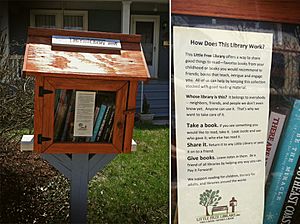
- The Harrison House: This stone house is very old. It was built around 1790. Even though Thomas Harrison died before it was built, it's still an important part of the city's history. It shows how buildings were made long ago.
- Hardesty-Higgins House: This house was built starting in 1848. It was home to Isaac Hardesty, Harrisonburg's first mayor. During the Civil War, a Union General stayed here. Today, it's used as the Harrisonburg Tourist Center.
- Harrisonburg Downtown Historic District: This area covers about 100 acres. It includes many old commercial buildings and churches. You can see different styles of architecture from the late 1800s and early 1900s. Many old buildings have been fixed up and given new uses.
Local Media
Harrisonburg has its own local TV station, radio stations, and newspapers.
- WHSV-TV (ABC channel)
- WMRA (public radio)
- The Daily News-Record (newspaper)
- The Harrisonburg Citizen (online news)
- The Breeze (James Madison University student newspaper)
Geography and Nature
Harrisonburg covers about 17.4 square miles. Most of it is land, with a small amount of water. The city has six main water areas, and Blacks Run is the biggest. All the water in Harrisonburg eventually flows into the Chesapeake Bay.
Harrisonburg is in the western part of the Shenandoah Valley. The area has rolling hills and small mountains. The weather here has four clear seasons: hot, humid summers and cool to cold winters.
Population Changes
Harrisonburg has grown a lot over the years. In 1860, about 1,000 people lived here. By 2020, the population was over 51,000!
The city is very diverse. In 2020, about 60% of people were White. About 7.5% were Black or African American. About 4% were Asian. And about 23% of the population was Hispanic or Latino. This shows how many different cultures live in Harrisonburg.
Many young people live in Harrisonburg because of the universities. The average age in the city is about 22.8 years old.
Education in Harrisonburg
Harrisonburg has a good school system for kids from kindergarten to 12th grade.
Public Schools
Harrisonburg City Public Schools serves about 4,400 students.
- High Schools:
* Harrisonburg High School * Rocktown High School
- Middle Schools:
* Skyline Middle School * Thomas Harrison Middle School
- Elementary Schools:
* Bluestone Elementary * Smithland Elementary * Spotswood Elementary * Stone Spring Elementary * Waterman Elementary * W.H. Keister Elementary
Colleges and Universities
- James Madison University (JMU): A large public university.
- Eastern Mennonite University (EMU): A private university.
Other Schools
- Massanutten Technical Center (for technical skills)
- Eastern Mennonite School (a private school for K-12)
Places to See and Things to Do
- Hardesty-Higgins House Visitor Center: Learn about the city's history.
- Edith J. Carrier Arboretum: A beautiful garden and nature area.
- Downtown Harrisonburg: Explore historic buildings, shops, and restaurants.
- Virginia Quilt Museum: See amazing quilts and learn about their history.
- Heritage Oaks Golf Course: A place to play golf.
Events and Festivals
Harrisonburg has many fun events throughout the year:
- The Alpine Loop Gran Fondo: A big road-cycling event.
- Harrisonburg International Festival: Celebrates different cultures with food, dance, and music.
- Valley Fourth: Downtown's Fourth of July celebration with food, music, and fireworks.
- Taste of Downtown: A food event in March to try local dishes.
- MACROCK: An independent music festival in April.
- Skeleton Festival: A community celebration that mixes Halloween and Dia de los Muertos. It has costumes, face painting, music, and more.
- Rocktown Beer & Music Festival: A popular spring event with many different beers and live music.
Sports Teams
Harrisonburg is home to several sports teams:
- Eastern Mennonite Royals: College sports teams (NCAA Division III).
- Harrisonburg Turks: A baseball team in the Valley Baseball League.
- James Madison Dukes: College sports teams (NCAA Division I). They have won national championships in field hockey, football, and women's lacrosse.
Famous People from Harrisonburg
Many interesting people have come from Harrisonburg, including:
- Dell Curry: A former NBA basketball player. He is the father of NBA stars Stephen Curry and Seth Curry.
- Old Crow Medicine Show: A popular music band.
- Ralph Sampson: A former NBA basketball player.
- Maggie Stiefvater: A bestselling author of young adult books.
- Kristi Toliver: A current WNBA basketball player and NBA assistant coach.
Images for kids
See also
 In Spanish: Harrisonburg para niños
In Spanish: Harrisonburg para niños





